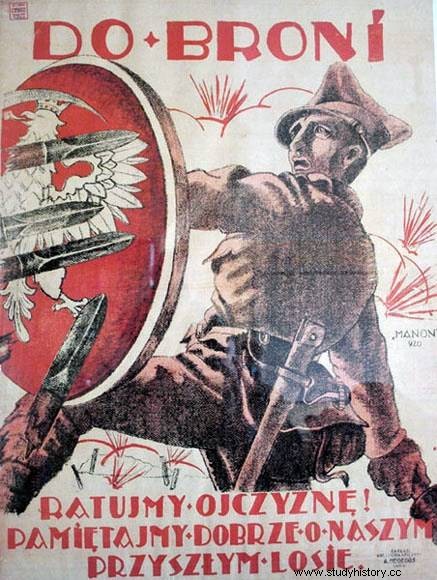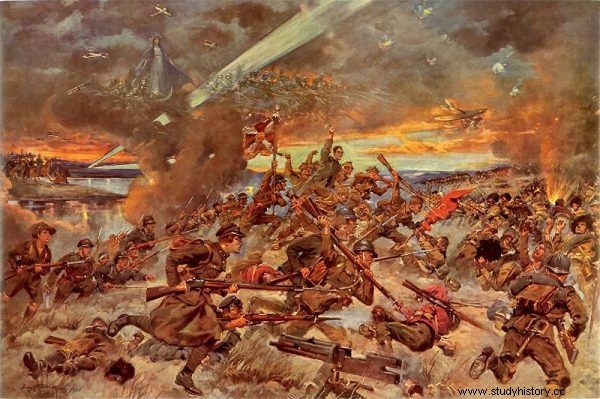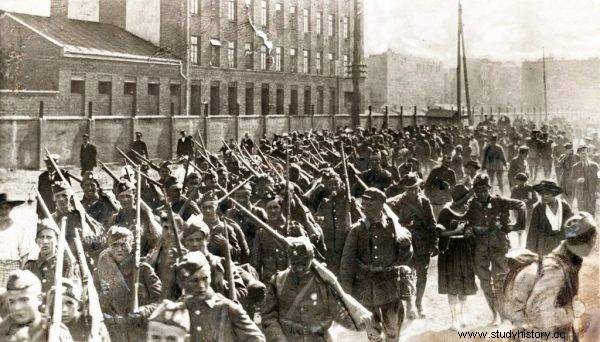The Battle of Warsaw is presented as a clash of the titans that decided the shape of Europe. The truth is quite different. Was there no miracle on the Vistula River?
The Battle of Warsaw of 1920 occupies a place in Polish collective memory, perhaps not central, but quite important. In the peculiar geography of lieux de mémoire one should probably look for it in the vicinity of the Battle of Grunwald.
Same summer season, same decisive (at least in the short term) character and similar styling , made jointly and severally by contemporary and posterity seers in both of these clashes something like the war of the worlds , they weigh in the collective imagination more than the trivial five centuries of interval. From such ahistorical perspective, it is still the same story of a great victory over a powerful enemy. Victoria, the fruit of which was unfortunately wasted without killing the defeated.
Eighteenth. Almost like the first
Both victorious clashes have their own symbols and quotes (true or apocryphal, it doesn't matter much), without which it is difficult to imagine their functioning in the public space. This role is played, for example, by two naked swords . Two quotes are an obligatory element of the narrative about the Battle of Warsaw.
One is a fragment of an order commanding the Bolshevik offensive by Mikhail Tukhachevsky:" Through the troupe of White Poland, the road leads to a global fires. We will bring happiness and peace to the working masses with our bayonets. ”

Both victorious clashes had their own symbols and quotes
The second one is actually not so much a quote as the title itself: The Eighteenth Decisive Battle of the World, Warsaw 1920 . A booklet under this title was published in 1931 by Edgar Vincent, 1st Viscount D'Abernon, whose message only says that he was a British diplomat. In a hypothetical list of commonly known historical quotations about Poland and Poles, both of these statements are undoubtedly at the forefront.
This pride of place is not without consequences, nor is it a coincidence. Tukhachevsky and Vincent simply fit perfectly into the image of the Battle of Warsaw and the entire Polish-Bolshevik war that best suited the historical policy of interwar Poland. It is characteristic that the authors of the words so often cited are not the object of deeper interest of Polish researchers. They said what needed to be said, and you can basically stop there.
Mysterious Piccadilly stallion
Mikhail Tukhachevsky, a victim of the Stalinist purges, is still a moderately known figure in this duo, although his main achievement - an offensive tactic successfully implemented by his students in 1944 and 1945 - necessarily pale in comparison to the maneuver of Polish defenders from the Wieprz River, whoever would be the originator of this maneuver.
On the other hand, Lord D'Abernon is known to Poles only from his small publication, or rather only from its title. It is a pity, because he is quite a colorful character. Nicknamed the Piccadilly stallion (as a handsome man he did not hesitate to make use of this fact, also no longer being a bachelor), was a typical product of the British political class. Without any special talents in any direction felt ready to hold any function, however important and profitable.

The text is an excerpt from the book by Maciej Górny, "Poland without miracles. A story for adults ”, which has just been released by Agora publishing house.
They happened different. Directly before the diplomatic mission in Poland, he chaired a committee that developed recommendations on the harmfulness of alcohol consumption (the committee, in a conservative spirit, decided that drinking in moderate amounts is not dangerous, unless it hurts someone . What a moderate amount means is left to the committee for further investigation.
In a more spectacular way, Vincent went down a little earlier in economic history, being the main perpetrator of a serious financial scandal. In 1895, as the director of the Ottoman Bank (a joint venture of British, French and Turkish capital) in Istanbul, he successfully kicked off the boom for investments in South African mines. After several months of madness, the shares of these mines fell sharply, and thousands of Turkish investors were left without money. Our hero naturally emerged from this confusion as a wealthy man, because he was able to enjoy privileged access to information.
Immediately before deleting the words that gave him an introduction to Polish school textbooks, Vincent held the position of the British ambassador to Berlin. He went down in the annals as a friend of Germany, convinced of their will for peaceful coexistence and the need for London to cooperate with the Weimar Republic . For this reason, he was called "apostle of appeasement" . It is this authority that has been reassuring us for many years that the Battle of Warsaw was one of the most important in the history of the world.
Sami against "worldwide conflagration"
After 1989, we are again dealing with essentially the same interpretation of this event, but even more stripped of embarrassing questions, devoid of some secondary elements and simplified. Adapted to the perception and imagination of generations that can no longer relate those events to their own experiences, and most often even to the experiences of their family members. From the beginning, the gaping man holds up only by the strength of faith, habit and thoughtlessness.
What is this picture? First of all, impressive in size, which both quotes perfectly emphasize. The Battle of Warsaw was one of the most important and decisive battles in the history of mankind, because it stopped the "global conflagration" . Can you imagine a greater geopolitical threat than Russia in the hands of the madmen?

In the interwar period, its historical importance was raised at that time by a quite obvious analogy with the first battle of the Marne.
Stopping the impending catastrophe is a deed of great importance. If we look closely, we can see that the immortal meaning of the Battle of Warsaw was and is, in a sense, borrowed. In the interwar period, its historical importance was raised by a quite obvious analogy with the first Battle of the Marne (the one in which taxis ran between the front and nearby Paris, taking the wounded and bringing supplies and ammunition). Just like the French, the Poles stopped a powerful enemy advancing from the east on the outskirts of their capital city.
Today this analogy has faded, but a different mechanism is at work. It consists in identifying the Soviet Russia of 1920 with the Stalinist juggernaut of the following decades. The easier it is because Stalin personally took part in the fight against the Poles. In fact, he is sometimes even blamed for the failure in this war. Poland defeating the Soviet Union (although it was still Soviet Russia at the time) sounds like a really great victory over the world power.
The numbers don't lie?
The realities make us look at the Polish-Bolshevik war in a completely different way. Not that historians have overlooked some key facts that will now turn the dominant interpretation of battle and war upside down. Historians, even those most haunted by the spirit of patriotism, are well aware of these facts. The only problem is that they don't draw conclusions from them.
Let's start with the image of the clash of the titans. We immediately encounter a problem here. The sheer number of fighters or the losses suffered by Poles and Bolsheviks do not justify the use of great quantifiers , especially a few years after the millions of victims of World War I.

Just over 4,000 soldiers died on the Polish side near Warsaw, and several times more were wounded.
Let's start with the fact that the condition of both armies did not allow for precise determination of numbers. We can only operate with estimates. Just over 4,000 soldiers died on the Polish side near Warsaw, and several times more were wounded. The exact losses of the enemy are unknown, mainly because he escaped quickly and in great disarray. On the other hand, forces oscillating around 40,000 soldiers on each side fought each other. If we return to the Marne for a moment, we notice that in 1914 these numbers were almost twenty times higher in France. The Miracle on the Marne cost much, much more than the Miracle on the Vistula.
This difference is intriguing primarily because it is not sufficiently explained by the scale of the conflict. In theory, millions of conscripts also took part in the Polish-Bolshevik war. On the Polish side, the numbers were around a million, on the Bolshevik side around 5 million. These numbers are smaller than on the Western Front of the Great War, but fully comparable to it.
What was the truth like?
But even according to optimistic estimates, no more than a third of these recruits served at the front. Lech Wyeszczski estimates that just after the Battle of Warsaw, only about 150,000 soldiers were effectively involved in the fight on the Polish side and on the Bolshevik side even less.
These relatively small forces operated in areas much larger than northern France, and at a very rapid pace. Especially in the period just before and after the Battle of Warsaw, the troops covered huge sections on foot or underwater, often without encountering the enemy at all. " The offensive was so strenuous [done], as lightning fast as I have not seen before. Suffice it to say that we went for a six-day walk:Lubartów - Białystok. Not bad "- this is Władysław Broniewski, whose concise notes well reflect the nature of this crazy campaign.

Just after the Battle of Warsaw, only about 150,000 soldiers were effectively participating in the battle on the Polish side.
About 40 kilometers a day on the offensive means a similar distance in retreat, about which Isaac Babel wrote much more poignantly. Wacław Lipiński, a historian and officer with the experience of the Great War in the ranks of the Legions, commented freshly:
[…] the fighting in Lithuania with the Moscow Bolshevik is fundamentally different from the way in which the war was conducted so far during the last four years of the European war. Even the Polish-Ukrainian war had a different character compared to those fights that are taking place in this area. This special character of the Lithuanian war is made up of two main factors, apart from many ancillary ones:large areas with a small number of troops, and therefore a mobile war.
Not too many troops in a vast space - this is perhaps the shortest definition of the Polish-Bolshevik war. But these are not the only features that are at odds with the image reproduced on the occasion of subsequent anniversaries, i.e. with the vision of the war of the worlds. Let's take a look at the rest.
Source:
The text is an excerpt from the book by Maciej Górny, "Poland without miracles. A story for adults ”, which has just been released by Agora publishing house.
